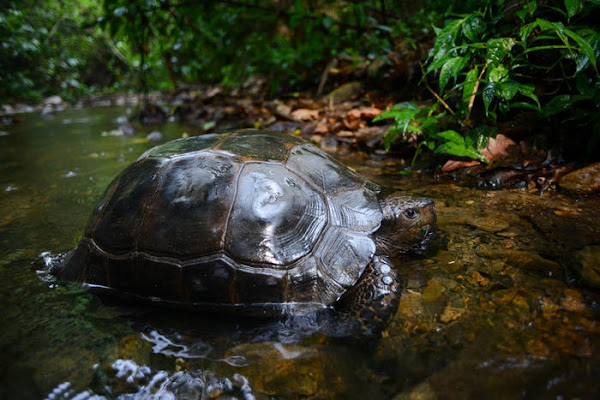Manouria emys (Asian Giant Tortoise)
The common name of this Tortoise in English is commonly called Asian Giant Tortoise, Asian Tortoise, Black Giant Tortoise, Burmese Brown Tortoise, Burmese Mountain Tortoise, Six-legged Tortoise, Brown Tortoise and Thai name called เต่าหก (Dtao Hok), เต่าหกดำ (Dtao Hok Dum).
เต่าหก : Manouria emys (Schlegel & Müller, 1844)
Manouria emys is a species of the Asian Tortoise Genus (Manouria) within the Tortoise Family (Testudinidae), Superfamily Testudinoidea, in the Suborder Cryptodira, in the Turtles Order (Testudines), in the Reptile Class (Reptilia), in the Chordate Phylum (Chordata) in the Animal Kingdom (Animalia).
Subspecies
- Manouria emys emys Hermann Schlegel & Salomon Müller, 1844
- Manouria emys phayrei Edward Blyth, 1854
Geographic Range
The range of Manouria emys occurs from Bangladesh and northeastern India through mid-elevation hilly areas of Myanmar, and western and southern Thailand through Malaysia and Indonesia (including Sumatra and Borneo) (Iverson 1992, Platt et al. 2018). Its presence in Brunei is uncertain. Records from Lao PDR, Viet Nam and southern China likely refer to M. impressa and/or traded animals.
The subspecies M. e. emys inhabits Thailand south of the Phang-nga-Surat Gap, Malaysia, Borneo and Sumatra. The subspecies M. e. phayrei occurs from Peninsular Thailand northwards through Myanmar to the northeastern Indian and eastern Bangladeshi hill tracts.
Habitat and Ecology
Manouria emys exclusively inhabits evergreen forest, from lowland regions up to altitudes of about 1,000 m (typically 600-1,500 m). The animals appreciate moisture and are typically found near water and frequently burrow in damp soil (Nutphand 1979). Lambert and Howes (1994) radio-tagged a female at Danum Valley in Sabah.
This animal ranged in an area of 0.6 km2 during 53 days of almost daily observation, her locations generally clustering for several days followed by a long walk of up to about 300 m, followed by another period spent in a limited area.
Wanchai (2008) found the species to utilise a range of habitats, including bamboo forest, dry evergreen forest mixed with bamboo, dry evergreen forest, stream courses and swampy stream edges.
Juveniles are rarely observed more than 20 m from streams; adults are also generally close to streams except during the raining season when they are seen to forage at greater elevations (Wanchai 2008).
During the dry season, most individuals become inactive for a period of up to two months, buried in litter or under tree falls.
The diet has been reported to include bamboo shoots, tubers and other juicy vegetation (Nutaphand 1979) and some invertebrates and frogs (Humphrey and Bain 1990).
Lambert and Howes (1994) observed their radio-tagged female feeding on 19 occasions, eating predominantly green leaves of understory plants and mushrooms, as well as some seedlings, sometimes including the roots, and fallen figs (Ficus punctata) on one occasion.
Animals of the nominate subspecies can reach up to 50 cm carapace length and 20 kg, while subspecies M. e. phayrei reaches 60 cm carapace length and 37 kg (Nutphand 1979). Size and age at maturity have apparently not been reported.
The social behaviour of this species is quite complex, with elaborate dominance and courtship rituals (described in captivity and illustrated in detail by McKeown et al. 1990).
Lambert and Howes (1994) noted (attempted) matings of their radio-tagged female at Danum Valley during 6-9 March and on 16 April by a different male; another mating was observed on 14 May. In captivity, a nest is constructed by the female by sweeping leaf litter backwards to form a nest mound.
In this mound, a clutch of on average 35 (range 15-51, N=24) spherical or slightly elongate eggs (41-54 mm diameter, weight 46-80 g) is laid, with larger females typically produces more eggs. The nest is defended against potential predators by the female during the first few days.
In captivity, M. e. phayrei reaches sexuality maturity at about 15 years (Fahz 2010). Longevity of this subspecies has been recorded up to 20 years, but it is likely to be much longer (Slavens and Slavens 2000). Generation length is estimated at about 45 years (three times age of maturity).
Synonym
- Geochelone emys Hermann Schlegel & Salomon Müller (1840)
- Testudo emys Hermann Schlegel & Salomon Müller (1840)
- Testudo emys Hermann Schlegel & Salomon Müller (in Coenraad Jacob Temminck) (1844)
- Testudo emydoides André Marie Constant Duméril & Gabriel Bibron (1851)
- Testudo phayrei Edward Blyth (1853)
- Teleopus luxatus John Lawrence LeConte (1854)
- Manouria emys phayrei Edward Blyth (1854)
- Manouria fusca John Edward Gray (1854)
- Manouria fusca John Edward Gray (1855)
- Manouria fusca John Edward Gray (1861)
- Manouria emydoides Alexander Strauch (1862)
- Manouria emys Alexander Strauch (1862)
- Manouria luxata Alexander Strauch (1862)
- Testudo (Scapia) falconeri John Edward Gray (1869)
- Scapia falconeri John Edward Gray (1870)
- Scapia phayrei John Edward Gray (1871)
- Testudo emys George Albert Boulenger (1889)
- Manuria emys Richard Lydekker (1889)
- Testudo emys R. Mell (1938)
- Geochelone emys Arthur Loveridge & Williams (1957)
- Geochelone emys Peter Charles Howard Pritchard (1967)
- Testudo nutapundi Reimann (1979)
- Geochelone nutapundi Wirot Nutaphand (1979)
- Geochelone nutapundi Brian Groombridge (1982)
- Manouria emys emys Fritz Jürgen Obst (1983)
- Manouria emys nutapundi Fritz Jürgen Obst (1983)
- Manouria emys phayrei Roger Bour (1984)
- Manouria emys Fritz Jürgen Obst (1985)
- Geochelone (Manouria) emys David Alderton (1988)
- Geochelone emys emys Jerzy Gosławski & Adam Hryniewicz (1993)
- Manouria nutapundi Fritz Jürgen Obst (1996)
- Manouria emys Ulrich Manthey & Wolfgang Grossmann (1997)
- Manouria emys phayeri Peter Paul (1997)
- Manouria emys Merel J. Cox et al. (1998)
- Manouria emys phayrei Roger Bour (1998)
- Testudo emys emys Peter Paul (1999)
- Manouria emys phayre Indraneil Das (2001)
- Manouria emys phareyi Ferri (2002)
- Manouria emys phayrei T.S.N. Murthy (2010)
- Manouria emys Turtle Taxonomy Working Group (TTWG) (2014)
